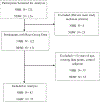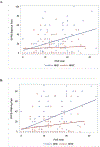Movement-evoked pain, physical function, and perceived stress: An observational study of ethnic/racial differences in aging non-Hispanic Blacks and non-Hispanic Whites with knee osteoarthritis
- PMID: 31154005
- PMCID: PMC6660381
- DOI: 10.1016/j.exger.2019.05.011
Movement-evoked pain, physical function, and perceived stress: An observational study of ethnic/racial differences in aging non-Hispanic Blacks and non-Hispanic Whites with knee osteoarthritis
Abstract
Background: Knee osteoarthritis (OA) is a pervasive musculoskeletal condition, often exacerbated by movement-evoked pain (MEP). Despite established research demonstrating significant racial differences in OA pain, few studies have investigated ethnic/racial group differences in MEP and lower extremity function and their association with psychosocial factors, such as perceived stress. Therefore, the primary aims were: (1) to identify ethnic/racial group differences in persons with or at risk for knee OA pain based on MEP, physical performance, and perceived stress measures, and (2) to determine if perceived stress explains the relationship between MEP and function in non-Hispanic Blacks (NHBs) and non-Hispanic Whites (NHWs).
Methods: A total of 162 NHB and NHW community-dwelling older adults (50-78 years of age) were included in this analysis from the Understanding Pain and Limitations in Osteoarthritic Disease (UPLOAD) cross-sectional cohort study. Demographic, anthropometric, pain and functional parameters were assessed using a battery of validated instruments. Descriptive statistics, parametric, and multivariate analyses were conducted to determine ethnic/racial differences in perceived stress, MEP, and function.
Results: Our results support the hypothesis that among persons with knee OA pain, NHBs have significantly greater MEP and lower functional level, despite similar levels of perceived stress. However, perceived stress was more strongly related to MEP in NHB compared to NHWs. Differences in function were limited to walking speed, where NHWs demonstrated faster gait speed.
Conclusions: Our cross-sectional study demonstrated important ethnic/racial differences in MEP and function. Also, perceived stress had a stronger effect on MEP in NHBs, suggesting that perceived stress may more strongly influence pain with physical movement among NHB adults. MEP may be a clinically important pain outcome to measure in persons with OA, and these data warrant future research on the impact of stress on pain and functional outcomes in older adults, particularly in NHBs.
Keywords: Ethnicity/race; Function; Movement; Osteoarthritis; Pain; Stress.
Copyright © 2019 Elsevier Inc. All rights reserved.
Conflict of interest statement
Figures



References
-
- Ahmed AT, Mohammed SA, Williams DR. Racial discrimination & health: pathways & evidence. Indian J Med Res 2007;126(4):318–27. - PubMed
-
- Altman R, Asch E, Bloch D, Bole G, Borenstein D, Brandt K, et al. Development of criteria for the classification and reporting of osteoarthritis: classification of osteoarthritis of the knee. Arthritis & Rheumatology 1986;29:1039–49. - PubMed
Publication types
MeSH terms
Grants and funding
LinkOut - more resources
Full Text Sources
Medical

